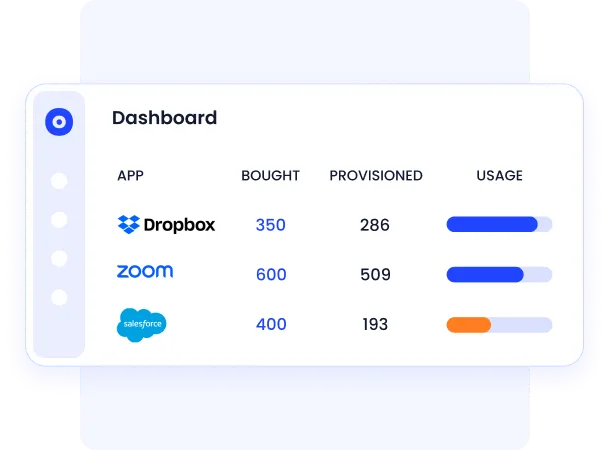HIPAA Compliance Checklist for 2025

Ever learned about a SaaS app only when the invoice showed up? You’re not alone. A new Cloud Security Alliance survey found that 55% of organizations experienced a SaaS security incident in the last two years, with misconfigurations, risky access, and tool sprawl leading the cascade.
Shadow IT has become the silent culprit behind those surprises, expanding attack surface, spreading sensitive data, and leaking budget in places no one’s watching.
This article breaks down the five SaaS categories most responsible for Shadow IT, the risks they trigger across security and spend, and practical ways to regain visibility before the next incident hits.
TL;DR
- Shadow IT grows when teams adopt SaaS apps outside IT visibility, creating hidden risks and spend.
- The most common sources include messaging, project management, file sharing, learning platforms, and video conferencing tools.
- Unmanaged SaaS leads to exposed data, surprise renewals, and duplicate tools with low usage.
- Organizations can reduce Shadow IT with SSO enforcement, spend monitoring, direct SaaS integrations, and device-level visibility.
- CloudEagle.ai helps uncover every app in your stack, automate governance, and keep SaaS secure and cost-efficient.
1. What Is Shadow IT in the SaaS Era?
Shadow IT happens when teams adopt SaaS apps that never pass through IT’s approval, visibility, or governance. It’s rarely malicious. Someone just wants to move faster, solve a workflow gap, or try a tool that promises better productivity.
But when those apps operate outside central oversight, access, data, and spend slip into the dark. Sensitive files end up in personal drives. Free trials quietly become paid subscriptions. Users come and go, but access stays.
And the growth is explosive. With SaaS adoption democratized, anyone with a company email and a credit card can introduce new software into the environment, no provisioning ticket required.
Shadow IT isn’t just “IT not knowing about a tool.” It’s:
- Data stored in unmanaged cloud apps
- Logins that bypass identity and access controls
- Costs are buried across departments and cards
- Risk without accountability
The result? A fragmented SaaS ecosystem where critical business operations run on tools that security can’t secure and finance can’t forecast.
Shadow IT is no longer a side effect of innovation in a SaaS-first world; it’s a fundamental threat vector organizations must tackle head-on.
2. Why Has SaaS Made Shadow IT Harder to Control?
SaaS flipped the rules of software adoption. What used to require IT reviews, security checks, and procurement approval now takes a browser, a credit card, and a deadline to hit. The result: tools enter the business faster than they can be tracked.
Here’s what changed:
1. Anyone can introduce software:
Free trials, monthly billing, and self-signup mean users bypass IT without even realizing it. Productivity wins in the moment, but governance disappears in the background.
2. Visibility doesn’t live in one place anymore:
Shadow apps connect through personal accounts, browser extensions, and OAuth approvals that IT never sees. Data moves from sanctioned apps into unmanaged ones instantly and silently.
3. Every new app expands the attack surface
If security can’t monitor the app, it can’t enforce access controls, detect misconfigurations, or revoke access when users leave. A single shadow integration can expose sensitive data to third parties.
4. Remote work accelerated independence
Distributed teams solve local problems with whatever SaaS is fastest. Security guardrails come later, if at all.
The modern SaaS model democratized innovation and, with it, democratized risk. Shadow IT isn’t happening because teams don’t care about security. It’s happening because SaaS has made moving fast easier than staying controlled.
3. Which SaaS Apps Create the Most Shadow IT?
Certain types of SaaS tools are adopted faster than they’re governed, and that’s where Shadow IT tends to surface. These categories help people move quickly, but also put data, access, and budgets outside centralized oversight.
Below are the five most common sources:
When teams pick their own chat tools
Messaging drives daily collaboration, so teams default to whatever helps them communicate instantly.
Where this happens:
- Chat apps like Slack, WhatsApp, and Telegram are used for internal conversations
- Personal accounts driving business communication
- New hires collaborating before official access is provisioned
Impact: Important decisions and sensitive data move into spaces that security can’t oversee or archive.
Project tools everyone signs up for
Free and simple project platforms promise structure without IT tickets.
Examples:
- Trello and Asana boards spun up outside governance
- Project docs stored in personal-linked online workspaces
- Multiple PM tools causing confusion in ownership
Impact: Scattered execution and duplicated tasks result in lost visibility into how work actually happens.
File sharing apps beyond IT’s radar
Friction in official collaboration tools leads users toward file sharing they already trust.
Typical behaviors:
- Personal Google Drive, Dropbox, iCloud for work files
- Public sharing links with no expiration
- Restricted data saved in unsanctioned cloud locations
Impact: Sensitive data travels and persists in places IT can’t manage or recover.
Learning tools that don’t follow the rules
LMS and training platforms often request access to internal content and identity data.
Shadow patterns:
- Sales or HR teams onboarding users directly into training tools
- AI learning platforms storing proprietary information
- Records of employee performance outside compliance tracking
Impact: PII and confidential content move outside regulated systems.
Video meetings happening outside IT
Client and vendor preferences often dictate which meeting tool gets used.
How it shows up:
- Zoom used even when Teams or Meet is the approved platform
- Meeting recordings saved in unmanaged cloud drives
- Guest and external account access left active
Impact: Uncontrolled access continues long after the meeting ends.
4. How Does Shadow IT Impact Security and Budget?
Shadow IT disrupts both operational control and financial clarity. When apps enter the business without oversight, access governance weakens and spending becomes unpredictable, often unnoticed until it’s too late.
Sensitive data without guardrails
Unapproved apps don’t follow enterprise controls, which means:
- Data stored in vendors' IT hasn’t been vetted
- OAuth permissions grant broad access to corporate systems
- No MFA, encryption, logging, or lifecycle management
- Former employees maintain access long after they leave
As stated above, 55% of organizations experienced a SaaS security incident in the past two years, many tied to misconfigurations and unmanaged access.
→ Security can’t protect what it can’t see.
Surprise renewals that drain budgets
Shadow IT produces hidden costs that finance teams can’t forecast:
- Free trials quietly convert to paid plans
- Department cards are scattered across multiple tools
- Contract renewals trigger charges without approvals
- Duplicate apps solve the same problem in different teams
Small monthly subscriptions compound quickly, and vendors rely on that visibility gap.
→ Budget accountability disappears when apps bypass procurement.
Too many tools, too few users
SaaS sprawl creates inefficiency, not productivity:
- Multiple apps overlapping in functionality
- Underutilized licenses due to low adoption
- Siloed data makes alignment difficult
- Admin workloads increase with every new login and integration
Even the best stack becomes unsustainable when redundant tools create more surface area than value.
Shadow IT isn’t an IT-only problem. It becomes a spending problem for finance and a risk problem for security, all rooted in the same visibility gap.
5. How Can Organizations Detect and Reduce Shadow IT?
Organizations can reduce Shadow IT by improving visibility across users, applications, access, and spending. With the right detection methods in place, hidden tools can quickly transition into secure, managed, and cost-efficient systems.
Start with your SSO and access controls
Centralizing identity is the fastest way to reveal unmanaged access.
What to enable:
- Enforce SSO for every approved SaaS application
- Require MFA for privileged roles
- Review unfederated apps connected via email signup
- Monitor when users grant OAuth access to third-party tools

This creates a baseline source of truth about who is using what and where access needs to be governed better.
Track what’s being paid for
Financial visibility exposes tools IT can’t see on the network.
Look for:
- Department-level SaaS payments on corporate cards
- Auto-renewal charges with unknown owners
- Duplicate tools solving the same problem
- Zero-usage licenses tied to departed employees

When finance and IT intelligence align, hidden spend becomes governable spend.
Connect SaaS apps directly for clarity
APIs tell a different story than sign-in logs.
What direct integrations discovers:
- Real user activity, not just login counts
- Accurate inventory of entitlements and admin privileges
- Unused licenses that should be reclaimed
- Continuous monitoring of access rights and changes

Integrations surface the context required to right-size access and eliminate inefficient tools.
Add visibility at the browser and device level
Some Shadow IT never touches your SSO or payment systems, but users access it daily.
What endpoint and browser monitoring reveal:
- SaaS accessed on unmanaged devices
- AI tools and extensions are extracting sensitive data
- App usage that never appears on IT’s radar
- Risks tied to personal email accounts

This completes the view: apps discovered even before they become a risk.
6. Bring Every SaaS App Into the Light
Shadow IT becomes manageable when you can see who’s using what, where data goes, and how spending grows. Visibility brings control without slowing teams down.
CloudEagle.ai gives you that clarity by automatically discovering apps, exposing real usage, and governing access with confidence. No surprises alerts or working in silos. Just a secure and efficient SaaS ecosystem you can trust.
Explore how CloudEagle strengthens SaaS visibility and access governance, book a quick demo to get started.
.avif)
%201.svg)







.avif)




.avif)
.avif)




.png)








